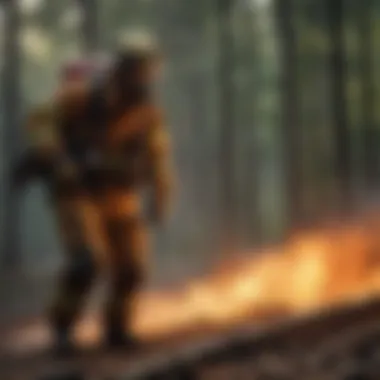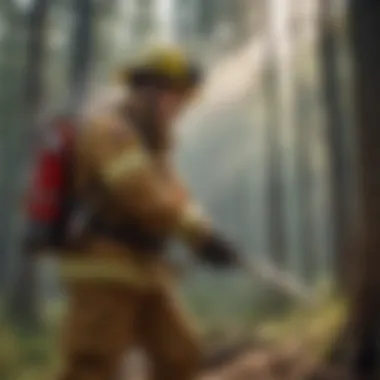Understanding Firefighting Physical Tests Explained


Intro
In the field of firefighting, physical fitness is critically important. This article examines the various physical tests that are fundamental to the firefighting profession. Understanding these tests helps firefighters maintain peak operational readiness. The physical requirements of firefighting go beyond basic strength and endurance. They encompass a wide range of capabilities crucial for navigating hazardous environments and effectively executing emergency response tasks. This overview aims to clarify the key components of these assessments and their relevance to prospective and existing firefighters.
Overview of Physical Testing in Firefighting
Physical testing for firefighters usually includes a variety of assessments. These may cover cardiovascular endurance, muscle strength, flexibility, and agility. Each test serves a specific purpose in evaluating a candidate's readiness for the demands of firefighting.
Key tests often include:
- The Candidate Physical Ability Test (CPAT): This is recognized as a standard test used across many departments. It mimics tasks that firefighters would perform on the job.
- Aerobic endurances tests: These tests gauge how well a firefighter can sustain physical activity over time.
- Strength assessments: These measure core and upper body strength, crucial for lifting equipment and carrying victims.
"Physical tests are not just about passing; they are essential in ensuring safety during actual emergency situations."
These assessments ensure that firefighters are not only physically capable but also mentally prepared.
Importance of Physical Readiness in Firefighting
Physical readiness is essential in firefighting. It correlates with safety and effectiveness on the job. Firefighters face unpredictable environments where physical and psychological resilience is tested.
For instance, a firefighter's ability to carry heavy equipment can directly impact their performance in crisis situations. Additionally, maintaining high levels of fitness can help reduce injury risks, ensuring that firefighters can respond effectively throughout their careers.
Focus on mental preparedness is also vital. Many departments now include psychological assessments as part of their testing protocol. This is to ensure that candidates can handle stressful situations that come with the job.
Training Methodologies
Training for firefighting physical tests is rigorous. Effective preparation requires a balanced approach, combining strength training, cardiovascular conditioning, and flexibility work.
Some effective training strategies include:
- Structured exercise programs: These programs should incorporate both aerobic and anaerobic exercises.
- Simulated firefighting drills: Practicing real scenarios provides candidates a clear expectation of what to face on the job.
- Regular assessments: Frequent evaluations help in tracking progress and adjusting training programs as needed.
Tailoring a training program to fit individual needs can enhance performance during physical tests. Moreover, consistency in training is key to long-term success in firefighting careers.
Implications for Recruitment and Career Longevity
The results of physical tests heavily influence recruitment decisions. Departments often use these tests to filter candidates based on fitness levels and operational readiness. Those who excel in these tests typically have a better chance of being selected.
Long-term career longevity also depends on one’s ability to maintain fitness levels throughout their service. Firefighters who prioritize physical health tend to experience fewer injuries and enjoy a more sustainable career.
In summary, understanding firefighting physical tests provides important insights into the profession. They ensure not only the individual’s readiness but also overall safety in firefighting. Aspiring firefighters and current professionals can benefit from acknowledging the significance of physical conditioning, training methodologies, and the long-term implications of these tests.
Prelims to Firefighting Physical Tests
The role of firefighting is fundamentally demanding. Firefighters face intense physical challenges that require not only strength but also stamina and agility. Understanding the protocols for physical testing is crucial in this field, as it directly influences a candidate's ability to perform under pressure. These assessments are designed to ensure that individuals can handle the various demands of firefighting operations, ultimately safeguarding lives and property.
Physical testing helps in identifying the essential fitness levels required for firefighters. This evaluation informs recruitment processes and subsequent training programs. It acts as a foundation for establishing the capabilities needed to execute emergency services effectively.
The Purpose of Physical Testing in Firefighting
The core purpose of physical testing in firefighting revolves around safety and preparedness. Firefighters must be ready to respond to emergencies that often require strenuous activity in unpredictable environments. By evaluating endurance, strength, and agility, the tests provide insight into an individual's readiness for these physically demanding tasks.
The results of these assessments are not just numbers on a paper; they have practical implications. For example, a firefighter lacking adequate physical fitness may struggle with tasks such as carrying heavy equipment or performing rescues, potentially endangering themselves and others. Thus, the testing is essential for ensuring that only those who meet the rigorous physical standards enter the profession.
Additionally, regular physical assessments promote ongoing fitness among current firefighters. By implementing standards, departments can develop training programs that are effective at maintaining or improving physical readiness over time.


Historical Context of Physical Requirements
Historically, firefighting standards have evolved in response to increased recognition of the physical demands of the job. In the early years, the physical fitness of firefighters was less formally defined. However, as urbanization and technology grew, so did the operational complexities of firefighting. Incidents involving towering infernos and hazardous material spills highlighted the need for exceptionally fit firefighters.
Regulatory bodies, such as the National Fire Protection Association, began to establish guidelines for physical performance, acknowledging that physical fitness directly correlates with job effectiveness. Over the decades, these standards have been refined based on research and incident analysis, leading to more specific requirements defining what it means to be fit for duty.
Today, physical testing is integrated into the recruitment process, ensuring that candidates are assessed against standardized criteria. This historical shift emphasizes the ongoing importance of maintaining physical readiness in the firefighting profession.
Key Components of Firefighting Physical Tests
The effectiveness of firefighters in various situations hinges on their physical capabilities. The components of physical testing play a crucial role in determining an individual's readiness for demanding tasks encountered in the field. Understanding these components is essential for prospective firefighters, trainers, and those involved in crafting recruitment standards. Each element of the physical tests evaluates different aspects of fitness that are vital to the role of a firefighter. This not only ensures safety but also reinforces the team's operational efficiency.
Endurance Assessments
Endurance assessments test the stamina of a firefighter over an extended period. Firefighting activities can demand prolonged exertion, especially during emergencies where every second counts. These assessments often involve running, stair climbing, or swimming tasks that mimic real-life scenarios.
The results from endurance tests assist in predicting how well a firefighter can perform under stress. Effective endurance is linked to lower fatigue levels and improved decision-making capabilities, which are crucial during emergencies. It becomes essential for fire departments to implement vigorous endurance training to prepare their teams for potential long calls.
Strength Criteria
Strength criteria focus on the muscular strength required for the various tasks faced on the job. This might include lifting heavy equipment, carrying a person to safety, or breaking down a door during an emergency. Strength tests often involve weightlifting or resistance exercises that directly assess muscle power.
Adequate strength not only helps in performing physical tasks but also impacts overall physical resilience, thereby reducing the risk of injury. Firefighters with good strength levels can carry more equipment safely and efficiently. Training programs designed around these criteria emphasize building muscle effectively.
Agility and Coordination Tests
Agility and coordination tests evaluate the ability of firefighters to move quickly and efficiently. In emergency situations, agility can mean the difference between success and failure. For instance, navigating through a tight space or avoiding obstacles while carrying gear is often required.
These tests usually consist of obstacle courses that require quick changes in direction and precision in movement. The performance in agility tests indicates how well a firefighter can maneuver during a crisis, enhancing their operational success rate. Regular training that incorporates agility boosting exercises can foster the necessary skills for effective firefighting.
Simulated Firefighting Scenarios
Simulated firefighting scenarios bridge the gap between theoretical knowledge and real-world application. This component involves replicating actual firefighting tasks in a controlled environment. It can include tasks like dragging hoses, operating extinguishers, or carrying injured persons.
Sharing the experience through simulations allows firefighters to practice their skills, build confidence, and refine their techniques. These simulations also serve to evaluate readiness and expose areas for improvement in physical capabilities. Training under these conditions prepares firefighters to respond effectively when faced with real emergencies, fostering a culture of preparedness.
By integrating these key components into a comprehensive testing framework, fire departments can ensure that their personnel maintain high fitness levels. This structured approach aids recruitment efforts and improves long-term career survival overall.
Testing Protocols and Standards
Testing protocols and standards are foundational in ensuring that fire personnel meet the physical demands of their role. These protocols serve as benchmarks for evaluating a firefighter's readiness and capability to perform essential duties in adverse conditions. Establishing these testing frameworks not only offers a systematic approach to assessing candidates but also sets a clear expectation for the physical fitness required of those in the profession.
The importance of protocols can be summarized in key elements:
- Reliability: Standardized tests provide consistency in evaluating all candidates. This ensures fairness in selection and compliance with established norms.
- Safety: By adhering to strict testing protocols, departments mitigate risks associated with hiring unfit individuals who may be unable to respond effectively in emergency situations.
- Training Focus: Clear standards guide training programs, allowing recruits to prepare specifically for the physical challenges they will encounter.
The development and implementation of testing protocols also necessitate consideration of various factors, such as the specific demands of firefighting duties and the physical variations among individuals. Thus, guidelines must be periodically reviewed to reflect modern practices and advancements in fitness research. This continuous evaluation is essential to adapt and improve protocols based on evolving needs within the firefighting community.
National Fire Protection Association (NFPA) Standards
The National Fire Protection Association has set forth specific standards that serve as benchmarks for physical testing in firefighting. These standards delineate the requirements for both physical capability and operational readiness. Generally, NFPA standards emphasize core performance areas:
- Aerobic fitness: Assessing endurance through tests like the 1.5-mile run ensures that firefighters can sustain prolonged exertion.
- Muscle strength and endurance: Tests such as the bench press or squat challenge the upper and lower body strength necessary for carrying equipment.
- Agility: Dynamic assessments ensure that candidates can maneuver effectively in constrained or rapidly changing environments.
Such punctilious standards reinforce the critical nature of being physically prepared. Regular updates to NFPA guidelines reflect changing technologies and methodologies in firefighting. Adhering to NFPA standards fosters a culture of accountability and excellence.
State and Local Variations


While NFPA standards provide a national framework, state and local variations account for regional needs and conditions. Different states may adapt the protocols to better fit the specific challenges faced in their geographical or operational contexts. Some common distinctions include:
- Test formats: Some localities may employ alternative formats or activities based on prevalent firefighting scenarios in their region.
- Thresholds for passing: Variations may exist in the minimum performance metrics, reflecting local emphasis on certain skills.
- Additional assessments: Certain areas may include assessments for environmental or situational preparedness as part of their protocol.
Understanding these state and local variations is crucial for both current firefighters and aspiring candidates. It provides insight into what to expect and how to prepare effectively for their specific area of operation. By recognizing these differences, officials can tailor their recruitment and training efforts, ensuring that all firefighters meet the demands of their unique environments.
Training for Firefighter Physical Tests
Training is a critical element in preparing for firefighter physical tests. This process goes beyond mere physical capability; it requires a comprehensive strategy that addresses various aspects of physical fitness, mental resilience, and recovery methods. Physical tests aim to simulate the intense conditions of firefighting, making effective training essential to ensure candidates can handle the demands of the job. A well-structured training regimen can ultimately influence performance in tests and, more importantly, in real-life firefighting situations.
Developing a Comprehensive Training Regimen
To prepare for physical testing, firefighters must develop a comprehensive training regimen that combines various fitness components. This includes endurance, strength, agility, and overall cardiovascular health. Here are key elements to consider:
- Assessment of Current Fitness Levels: Understanding the starting point is crucial. Conduct baseline fitness tests to evaluate strength, endurance, and flexibility.
- Tailored Exercise Plans: Create a plan that focuses on the necessary areas. For instance, combine weight training for strength, interval training for endurance, and drill exercises to improve coordination.
- Incorporation of Functional Training: Firefighters must perform tasks that closely resemble firefighting duties. Activities like lifting heavy loads, climbing stairs, or dragging equipment should be part of the training.
- Consistency and Frequency: Establish a routine that balances different training elements. Regular training sessions, spread throughout the week, can lead to gradual improvements in overall performance.
The key to a successful training regimen is adaptability. Monitor progress and make adjustments based on performance in physical tests. This can help pinpoint areas needing further improvement.
The Role of Nutrition and Recovery
Nutrition and recovery are foundational to achieving peak performance in physical testing. An often overlooked aspect of training, proper dietary practices can enhance physical capabilities significantly. Here are some important points:
- Balanced Diet: Focus on a diet rich in whole foods, including lean proteins, complex carbohydrates, and healthy fats. Nutritional needs may increase with more vigorous training, so ensure adequate intake to support recovery and performance.
- Hydration: Staying hydrated is fundamental. Dehydration can lead to a decline in performance, especially during physical tests.
- Post-Workout Recovery: Recovery should not be an afterthought. Engage in active recovery strategies, such as light exercise on off days, stretching, and foam rolling. This can mitigate soreness and improve muscle repair.
- Sleep and Mental Recovery: Quality sleep is essential. Aim for seven to nine hours to allow the body to recover physically and mentally.
"Proper nutrition paired with sufficient recovery is not just beneficial; it's crucial for sustaining high levels of performance during both training and testing."
Through integrating nutrition and recovery strategies within training, candidates can enhance their readiness for physical tests. A holistic approach ensures that all factors contributing to performance are addressed, providing a stronger foundation for success.
Psychological Preparedness in Physical Testing
Psychological preparedness is a key component that underpins the efficacy of physical testing in firefighting. The mental state of candidates can influence their ability to perform under the pressure typical of emergency situations. Preparing mentally is not just about having confidence; it involves developing resilience and coping strategies to manage the demands of both the tests and the actual firefighting work.
Mental Resilience and Performance
Mental resilience allows firefighters to recover from setbacks or failures during physical tests. It enables them to maintain focus, maintaining a clear mind even when fatigued or stressed. For this reason, preparation for physical tests should include psychological training. This may encompass techniques such as visualization and self-talk, which can enhance performance. Studies suggest that candidates who engage in mental skills training tend to have better outcomes in challenging scenarios.
"Mental toughness is just as crucial as physical capability; one impacts the other directly."
Routine exposure to difficult tasks can also contribute to building resilience. Practicing under simulation of high-stress situations provides a safe space to adapt to pressure, ultimately helping candidates succeed. Fostering a growth mindset, where setbacks are viewed as opportunities for learning, further enhances mental resilience during testing.
Impact of Stress on Physical Performance
Stress can significantly affect physical performance, and understanding this impact is vital for candidates. When under stress, the body releases cortisol, a hormone that can impair physical function and decision-making capabilities. This is particularly consequential in firefighting, where split-second decisions can mean life or death.
Moreover, high-stress levels can lead to physical symptoms such as increased heart rate and muscle tension. Candidates who prepare for their physical tests must learn how to recognize their stress responses and employ techniques to manage them effectively. Mindfulness practices and breathing exercises can be useful tools for navigating stressful situations, allowing for better concentration and stamina.
When stress management techniques are integrated into training programs, candidates are better equipped to handle the trials of both physical tests and real-life scenarios they will face in the field. These elements combined create a holistic approach to preparing for physical testing that emphasizes not only physical fitness but also psychological readiness.
Implications for Recruitment and Career Development
Physical testing in firefighting serves not just as a measure of fitness but also plays a critical role in recruitment and long-term career development for firefighters. Understanding these implications can enhance both the efficacy of the recruitment process and the sustainability of a firefighter's career. This section will explore how physical tests shape recruitment methodologies and support career longevity.
Physical Testing in Recruitment Processes
Recruitment for firefighting positions incorporates physical tests to ensure that candidates possess the necessary physical attributes and endurance required for the job. These tests focus on strength, agility, and endurance, critical factors that can affect operational effectiveness during emergencies.


In many departments, the initial phase of recruitment includes a physical agility test. This test typically comprises various exercises that simulate job-related tasks. For instance, lifting heavy equipment or climbing stairs under time constraints directly reflects the demands of the firefighting profession.
The benefits of such testing in recruitment include:
- Reduces Inefficiencies: By screening candidates through physical tests, departments can avoid selecting individuals who may lack the necessary physical capacity, thus saving resources in training and hiring.
- Enhances Team Performance: Uniform capability among recruits ensures that all members are able to perform at a similar level, reducing strain on more fit individuals during operations.
- Improves Public Safety: When only qualified candidates are hired, communities are better protected, as trained firefighters can handle emergencies more efficiently.
Moreover, the psychological aspect of these tests should not be overlooked. Candidates who perform well often feel a sense of accomplishment and readiness, which can ease the transition into the demanding environment of firefighting.
Career Longevity and Physical Fitness
The relationship between physical fitness and career longevity cannot be understated in the firefighting field. Firefighting is an inherently intense job that demands sustained physical prowess over time. Maintaining a high level of fitness can play a significant role in the duration of a firefighter's career.
A focus on ongoing physical assessments helps firefighters remain aware of their fitness levels throughout their careers. As they age, the challenges they face may evolve but keeping fit provides an advantage. Some key considerations include:
- Resilience Against Injury: Regular physical fitness training enables firefighters to build strength and flexibility, reducing the likelihood of injuries during calls.
- Mental Well-being: Physical activity is closely linked to better mental health. Firefighters who prioritize fitness may experience lower levels of stress and burnout.
- Enhanced Performance: Regular fitness routines not only help in managing weight but also improve overall endurance and strength, which are crucial in emergencies when every second counts.
In summary, integrating physical testing into the recruitment process provides essential insights into the candidates' potential and suitability. Furthermore, prioritizing physical fitness contributes greatly to a firefighter's ability to sustain a long, productive career. Understanding these implications helps pave the way for effective recruitment strategies and supports ongoing physical fitness programs that are vital for long-term success.
Future Trends in Firefighter Physical Testing
Firefighting physical tests are evolving in response to both technological advancements and a deeper understanding of human performance. As the demands on firefighters continue to grow, these physical assessments must remain relevant and effective. The importance of adapting physical testing protocols is crucial for ensuring that firefighters meet the rigorous and dynamic challenges of their roles. This section delves into the key advancements and standard changes shaping the future of firefighting physical tests.
Technological Advancements and Testing Techniques
The integration of technology into physical testing has transformed how assessments are conducted. Tools such as wearable fitness trackers and mobile applications allow for more accurate monitoring of key metrics, such as heart rate, endurance, and recovery times. These technological solutions provide real-time data that can be analyzed post-test to create tailored improvement plans for each firefighter.
Additionally, simulation technology is being employed to replicate real firefighting scenarios more closely. Virtual reality (VR) systems can immerse candidates in simulated environments, allowing for assessment under conditions that mimic actual physical and psychological stressors faced during firefighting operations.
Benefits of these advancements include:
- Increased accuracy in evaluating performance metrics.
- Personalized training plans based on specific data from assessments.
- Enhanced readiness through realistic simulations.
- Better assessment of mental resilience, as high-pressure situations can be tested in virtual environments.
As firefighters adapt to newer technologies, the expectations of their physical capabilities also rise. This necessitates continuous updates to training and assessment protocols.
Evolving Standards and Practices
Standards governing firefighter physical testing are continually being revised to meet new challenges. Organizations like the National Fire Protection Association (NFPA) play a vital role in shaping these standards to ensure they capture the evolving nature of firefighting work.
Key aspects of evolving standards include:
- Incorporation of functional fitness principles, emphasizing movements and tasks typical of firefighting duties.
- Regular reviews and updates to testing procedures based on new research in exercise science and physiology.
- Flexibility in standards that accommodate diverse capabilities among firefighters, recognizing that individual physical attributes can vary greatly.
"Only by adapting to the changing landscape of firefighting can physical testing accurately reflect the skills needed for today’s challenges."
As awareness grows regarding the importance of mental fitness alongside physical prowess, future standards will likely encompass psychological resilience as an integral part of testing. This holistic approach ensures that all aspects of a firefighter’s capabilities are assessed and enhanced.
Closure
The conclusion of this article serves as a critical synthesis of the information presented about firefighting physical tests. It encapsulates the various aspects of physical testing protocols and their role in shaping effective firefighters. The insights accrued throughout this piece reveal that these tests are not merely procedural requirements but essential components that uphold the safety and efficiency of firefighting operations.
Summary of Key Points
- Importance of Physical Testing: Physical tests are vital in assessing the readiness of firefighters. They measure endurance, strength, agility, and coordination.
- Training Regimens: Comprehensive training programs are required to prepare recruits and seasoned professionals alike for these demanding tests.
- Psychological Preparedness: Mental resilience is as crucial as physical abilities. The stress of firefighting situations necessitates a sound mind along with a fit body.
- Recruitment and Career Longevity: The assessment of physical fitness impacts recruitment strategies and influences career trajectories in firefighting.
- Future Trends: Advancements in technology may reshape testing methodologies, enhancing how readiness is gauged.
The Importance of Continuous Evaluation
Continuous evaluation of physical tests within the firefighting profession is paramount. As the nature of firefighting evolves, so too should the standards and protocols that govern physical assessments. Regular reviews ensure that tests remain relevant, challenging, and suited to the demands of modern firefighting.
Evaluating physical standards allows organizations to adapt to new safety practices and advancements in firefighting techniques. It fosters a culture of ongoing improvement, essential for maintaining high operational readiness. Keeping a close watch on physical requirements can help identify gaps where training may be insufficient, ultimately reducing risk and improving personnel effectiveness in emergencies.
"Preparedness is not just a routine but a continuous commitment to excellence in safety and performance."
In summary, the relentless pursuit of improvement and rigorous evaluation are indispensable in creating a workforce that is prepared to handle the unpredictable nature of firefighting. Not only does this benefit the individuals involved, but also the communities they serve.







